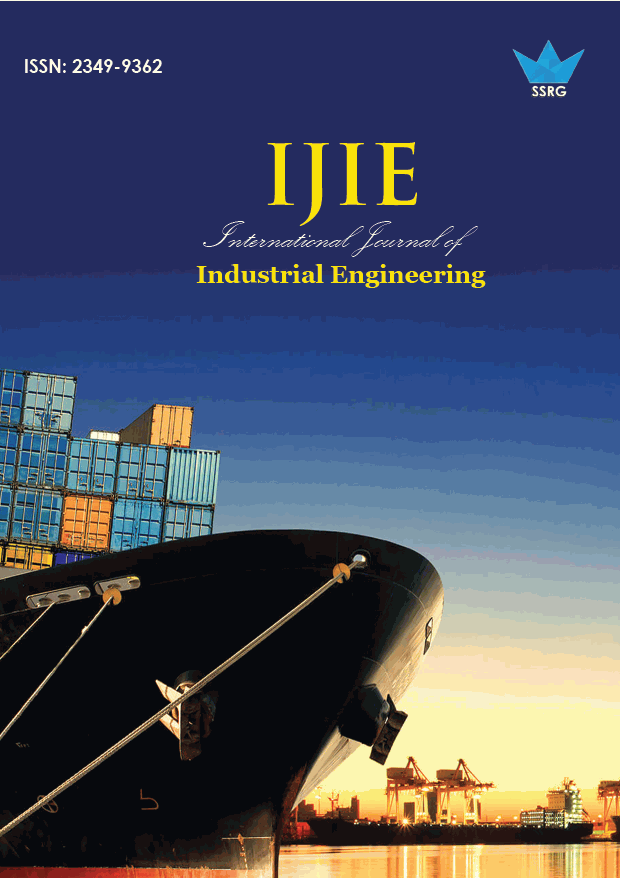The Effect of Turning on Home Composting

| International Journal of Industrial Engineering |
| © 2024 by SSRG - IJIE Journal |
| Volume 11 Issue 3 |
| Year of Publication : 2024 |
| Authors : Omem Paron |
How to Cite?
Omem Paron, "The Effect of Turning on Home Composting," SSRG International Journal of Industrial Engineering, vol. 11, no. 3, pp. 11-17, 2024. Crossref, https://doi.org/10.14445/23499362/IJIE-V11I3P103
Abstract:
The improper handling of waste generation ultimately harms living organisms and their environment. It is evident from the analysis that Municipal Solid Waste (MSW) has a high percentage of biodegradable waste; thus, composting could be considered a sustainable and systematic approach. Composting yard waste helps reduce the load on the disposal site and improves crop productivity by providing nutrient-rich compost. Aeration speeds up the degradation process. Two identical composting bins were designed to assess the effect of turning on composting, and the various controlling factors, such as temperature, moisture content, pH, organic carbon content, etc, were observed for 4 weeks. The pH gradually increases over time. The moisture content drops from 68.28% to 53.3% and 56.67%. The temperature for turning the thermophilic phase twice weekly was seen on the 6th day. After the 12th day, the temperature fluctuated within the mesophilic range for a turning interval of once a week. The thermophilic phase was observed between the 10th day and the 20th day. By observing the variation in controlling parameters, it was figured out that turning the composting bin once a week is the ideal frequency for turning for home composting, compared to twice a week. However, turning twice a week is also up to the harmless standard.
Keywords:
Solid waste management, Composting, Turning, Yard waste, Temperature, Emission.
References:
[1] N. Abdullah, and N.L. Chin, “Simplex Centroid Mixture Formulation Mixture for Optimized Composting of Kitchen Waste,” Bioresource Technology, vol. 101, no. 21, pp. 8205-8210, 2010.
[CrossRef] [Google Scholar] [Publisher Link]
[2] Bijaya K. Adhikari et al., “Home and Community Composting for On-Site Treatment of Urban Organic Waste: Perspective for Europe and Canada,” Waste Management & Research: The Journal for a Sustainable Circular Economy, vol. 28, no. 11, pp. 1039-1053, 2010.
[CrossRef] [Google Scholar] [Publisher Link]
[3] Ranjith Kharvel Annepu, “Sustainable Solid Waste Management in India,” Master Thesis, Waste to Energy Research and Technology Council (WTERT) Columbia University, New York, 2012.
[Google Scholar] [Publisher Link]
[4] Rajinder Singh Antil, and Dev Raj, “Chemical and Microbiological Parameters for the Characterization of Maturity of Compost Made from Farm and Agro-Industrial Wastes,” Archives of Agronomy and Soil Science, vol. 58, no. 8, pp. 833-845, 2012.
[CrossRef] [Google Scholar] [Publisher Link]
[5] Kadafa Adati Ayuba et al., “Current Status of Municipal Solid Waste Management Practice in FCT Abuja,” Research Journal of Environmental and Earth Sciences, vol. 5, no. 6, pp. 295-304, 2013.
[CrossRef] [Google Scholar] [Publisher Link]
[6] Suzelle Barrington et al., “Effect of Carbon Source on Compost Nitrogen and Carbon Losses,” Bioresource Technology, vol. 83, no. 3, pp. 189-194, 2002.
[CrossRef] [Google Scholar] [Publisher Link]
[7] M.P. Bernal, J.A. Alburquerque, and R. Moral, “Composting of Animal Manures and Chemical Criteria for Compost Maturity Assessment a Review,” Bioresource Technology, vol. 100, no. 22, pp. 5444-5453, 2009.
[CrossRef] [Google Scholar] [Publisher Link]
[8] A.D. Bhide, and B.B. Sundaresan, “Solid Waste Management in Developing Countries,” Indian National Scientific Documentation Centre, New Delhi, India, 1983.
[Google Scholar] [Publisher Link]
[9] Alessio Boldrin et al., “Composting and Compost Utilization, Accounting of Greenhouse Gases and Global Warming Contributions,” Waste Management & Research: The Journal for a Sustainable Circular Economy, vol. 27, pp. 800-812, 2009.
[CrossRef] [Google Scholar] [Publisher Link]
[10] Marcela Calabi-Floody et al., “Smart Fertilizers as a Strategy for Sustainable Agriculture,” Advances in Agronomy, vol. 147, pp. 119-157, 2018.
[CrossRef] [Google Scholar] [Publisher Link]
[11] Cecilia Sundberg et al., “Characterization of Source-Separated Household Waste Intended for Composting,” Bioresource Technology, vol. 102, no. 3, pp. 2859-2867, 2011.
[CrossRef] [Google Scholar] [Publisher Link]
[12] James I. Chang, and Y.J. Chen, “Effect of Bulking Agents on Food Waste Composting,” Bioresource Technology, vol. 101, no. 15, pp. 5917-5924, 2010.
[CrossRef] [Google Scholar] [Publisher Link]
[13] A. Chiumenti et al., “Swine Manure Composting by Means of Experimental Turning Equipment,” Waste Management, vol. 27, no. 12, pp. 1774-1782, 2007.
[CrossRef] [Google Scholar] [Publisher Link]
[14] O.O. Cofie et al., “Resource Recovery from Urban Waste: Options and Challenges for Community-Based Composting in Sub-Saharan Africa,” Desalination, vol. 248, no. 1-3, pp. 256-261, 2009.
[CrossRef] [Google Scholar] [Publisher Link]
[15] Hua, Dangling et al., “Effect of Turning and Covering Techniques on Pig Manure-Straw Composting,” Transactions of the Chinese Society of Agricultural Engineering, vol. 27, no. 12, pp. 210-216, 2011.
[Google Scholar] [Publisher Link]
[16] Nadine Dulac, The organic Waste Flow in Integrated Sustainable Waste Management, Tools for Decision – Makers- Experiences from the Urban Waste Expertise Programme, Netherland, 2001.
[Publisher Link]
[17] Eliot Epstein, The science of Composting, 1st ed., CRS Press, Boca Raton, 1997.
[CrossRef] [Google Scholar] [Publisher Link]
[18] Ezechi, Ezerie Henry et al., “Municipal Solid Waste Management in Aba, Nigeria: Challenges and Prospects,” Environmental Engineering Research, vol. 22, no. 3, pp. 231-236, 2017.
[CrossRef] [Google Scholar] [Publisher Link]
[19] Lilliana Abarca Guerrero, Ger Maas, and William Hogland, “Solid Waste Management Challenges for Cities in Developing Countries,” Waste Management, vol. 33, no. 1, pp. 220-232, 2013.
[CrossRef] [Google Scholar] [Publisher Link]
[20] Rui Guo et al., “Effect of Aeration Rate, C/N Ratio and Moisture Content on the Stability and Maturity of Compost,” Bioresource Technology, vol. 112, pp. 171-178, 2012.
[CrossRef] [Google Scholar] [Publisher Link]
[21] Trine L. Hansen et al., “Method for Determination of Methane Potentials of Solid Organic Waste,” Waste Management, vol. 24, no. 4, pp. 393-400, 2004.
[CrossRef] [Google Scholar] [Publisher Link]
[22] Rajkumar Joshi, and Sirajuddin Ahmed, “Status, and Challenges of Municipal Solid Waste Management in India: A review,” Cogent Environmental Science, vol. 2, no. 1, 2016.
[CrossRef] [Google Scholar] [Publisher Link]
[23] Frank Kalemelawa et al., “An Evaluation of Aerobic and Anaerobic Composting of Banana Peels Treated with Different Inoculums for Soil Nutrient Replenishment,” Bioresource Technology, vol. 126, pp. 375-382, 2012.
[CrossRef] [Google Scholar] [Publisher Link]
[24] Ajay S. Kalamdhad, and Absar A. Kazmi, “Rotary Drum Composting of Different Organic Waste Mixtures,” Waste Management & Research: The Journal for a Sustainable Circular Economy, vol. 27, no. 2, pp. 129-137, 2009.
[CrossRef] [Google Scholar] [Publisher Link]
[25] Joung-Dae Kim et al., “Evaluation of Pilot Scale In-Vessel Composting for Food Waste Treatment,” Journal of Hazardous Materials, vol. 154, no. 1–3, pp. 272-277, 2008.
[CrossRef] [Google Scholar] [Publisher Link]
[26] Sunil Kumar et al., “Assessment of the Status of Municipal Solid Waste Management in Metro Cities, State Capitals, Class I Cities, and Class II Towns in India: An Insight,” Waste Management, vol. 29, no. 2, pp. 883-895, 2009.
[CrossRef] [Google Scholar] [Publisher Link]
[27] Nabam Rich, and Ajay Bharti, “Assessment of Different Types of In-Vessel Composters and their Effect on Stabilization of MSW Compost,” International Research Journal of Engineering and Technology, vol. 2, no. 3, pp. 1-6, 2015.
[Google Scholar] [Publisher Link]
[28] Ashish Kumar Nayak, and Ajay S. Kalamdhad, “Stability, and Kinetic Analysis of Sewage Sludge Composting,” International Journal of Recycling of Organic Waste in Agriculture, vol. 4, pp. 249–259, 2015.
[CrossRef] [Google Scholar] [Publisher Link]
[29] R. Parkinson et al., “Effect of Turning Regime and Seasonal Weather Conditions on Nitrogen and Phosphorus Losses during Aerobic Composting of Cattle Manure,” Bioresource Technology, vol. 91, no. 2, pp. 171-178, 2004.
[CrossRef] [Google Scholar] [Publisher Link]
[30] Laurent Parrot, Joel Sotamenou, and Bernadette Kamgnia Dia, “Municipal Solid Waste Management in Africa: Strategies and Livelihoods in Yaounde, Cameroon,” Waste Management, vol. 29, no. 2, pp. 986-995, 2005.
[CrossRef] [Google Scholar] [Publisher Link]
[31] Sarika Rathi, “Alternative Approaches for Better Municipal Solid Waste Management in Mumbai, India,” Waste Management, vol. 26, no. 10, pp. 1192-1200, 2006.
[CrossRef] [Google Scholar] [Publisher Link]
[32] M. Reyes Torres et al., “A Systematic Review on the Composting of Green Waste: Feedstock Quantity and Optimization Strategies,” Waste Management, vol. 77, pp. 486-499, 2018.
[CrossRef] [Google Scholar] [Publisher Link]
[33] Luis Rodríguez et al., “Domestic Sewage Sludge Composting in a Rotary Drum Reactor, Optimizing the Thermophilic Stage,” Journal of Environmental Management, vol. 112, pp. 284-291, 2012.
[CrossRef] [Google Scholar] [Publisher Link]
[34] Anna Bernstad Saraiva Schott, Henrik Wenzel, and Jes la Cour Jansen, “Identification of Decisive Factors for Greenhouse Gas Emissions in Comparative Life Cycle Assessments of Food Waste Management-an Analytical Review,” Journal of Cleaner Production, vol. 119, pp. 13-24, 2016.
[CrossRef] [Google Scholar] [Publisher Link]
[35] Mufeed Sharholy et al., “Municipal Solid Waste Management in Indian Cities- A Review,” Waste Management, vol. 28, no. 2, pp. 459 467, 2008.
[CrossRef] [Google Scholar] [Publisher Link]
[36] H.S. Shin et al., “Performance of UASB Reactor Treating Leachate from Acidogenic Fermenter in the Two-Phase Anaerobic 5 Digestion of Food Waste,” Water Research, vol. 35, no. 14, pp. 3441-3447, 2001.
[CrossRef] [Google Scholar] [Publisher Link]
[37] V. Sudharsan Varma, and A.S. Kalamdhad, “Evolution of Chemical and Biological Characterization during Thermophilic Composting of Vegetable Waste Using Rotary Drum Composter,” International Journal of Environmental Science and Technology, vol. 12, pp. 2015 2024, 2015.
[CrossRef] [Google Scholar] [Publisher Link]
[38] Test Methods for Examination of Composting and Compost, US Composting Council, 2001. [Online]. Available: https://www.compostingcouncil.org/page/TMECC#:~:text=The%20Test%20Method%20for%20the,at%20the%20point%20of%20sale
[39] Sandra M. Tirado, and Frederick C. Michel, “Effects of Turning Frequency, Windrow Size and Season on Dairy Manure/Sawdust Compost Production,” Compost Science & Utilization, pp. 18, no. 2, pp. 70-80, 2010.
[CrossRef] [Google Scholar] [Publisher Link]
[40] V. Sudharsan Varma, Ajay S. Kalamdhad, and Bimlesh Kumar, “Optimization of Waste Combinations During In-Vessel Composting of Agricultural Waste,” Waste Management & Research: The Journal for a Sustainable Circular Economy, vol. 35, no. 1, pp. 101-109, 2017.
[CrossRef] [Google Scholar] [Publisher Link]
[41] Y. Jing Yuan et al., “Use of Additive and Pretreatment to Control Odors in Municipal Kitchen Waste during Aerobic Composting,” Journal of Environmental Sciences, vol. 37, pp. 83-90, 2015.
[CrossRef] [Google Scholar] [Publisher Link]
[42] Yudong Zhang et al., “Effect of Turning Frequency on Maturity during Kitchen Waste Composting,” Proceedings of the 2015 International Forum on Energy, Environment Science and Materials, 2015.
[CrossRef] [Google Scholar] [Publisher Link]
[43] Zhou Jiang-ming, “Effect of Turning Frequency on Co-Composting Pig Manure and Fungus Residue,” Journal of the Air and Waste Management Association, vol. 67, no. 3, pp. 313-321, 2017.
[CrossRef] [Google Scholar] [Publisher Link]

 10.14445/23499362/IJIE-V11I3P103
10.14445/23499362/IJIE-V11I3P103